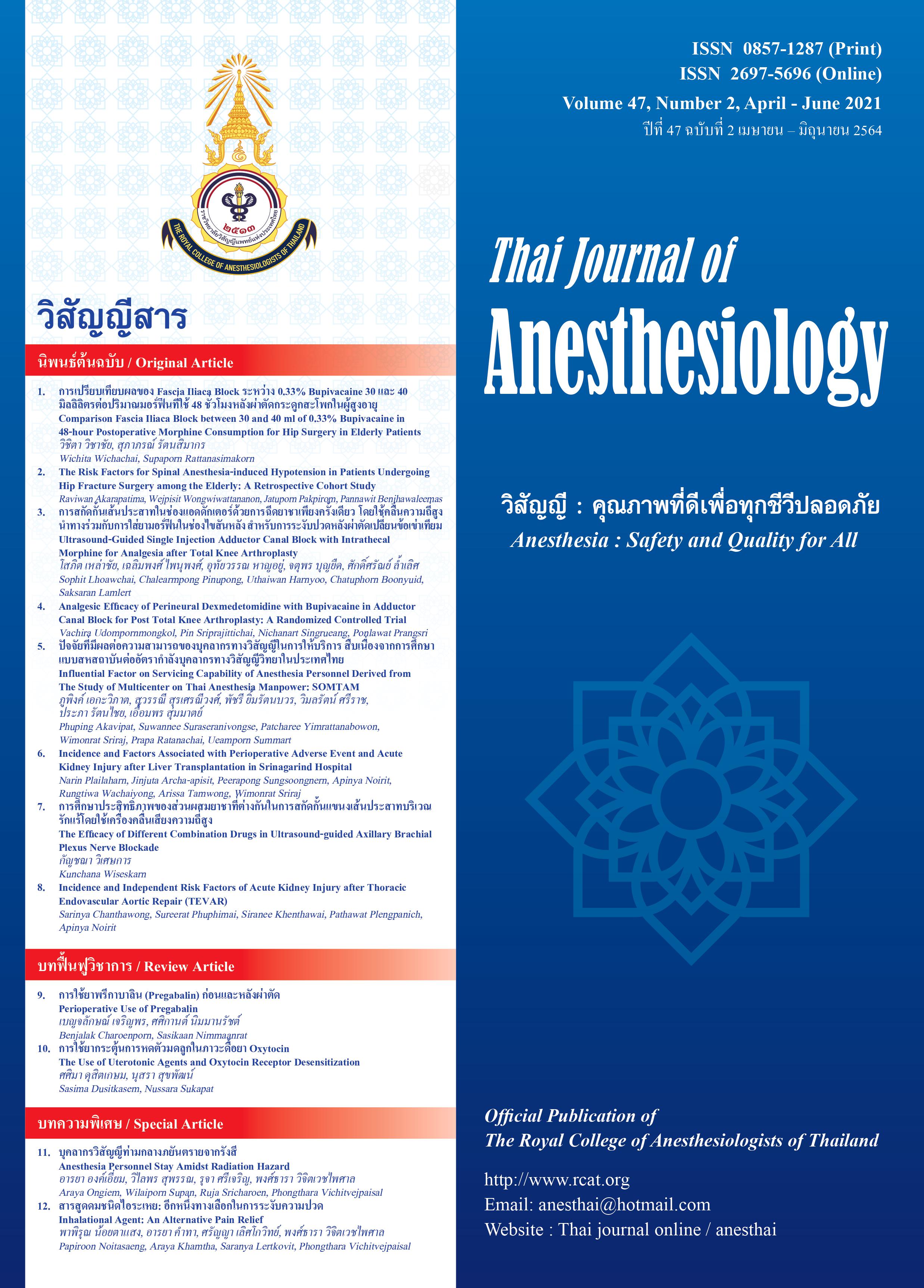Incidence and Factors Associated with Perioperative Adverse Event and Acute Kidney Injury after Liver Transplantation in Srinagarind Hospital
Main Article Content
Abstract
Background: Liver transplantation (LT), a standard treatment for patients with end stage liver disease. Acute kidney injury (AKI) is a common complication after LT and may affect long term outcomes. Perioperative adverse events can be associated with postoperative AKI. This study aimed to know the incidence and factors associated with adverse events and postoperative AKI in patients undergoing LT. Methods: Medical records of all patients aged 18 years and over undergone LT during the 13-year study period (February 2006 to May 2018) were reviewed. Preoperative patients’conditions, anesthetic management including intraoperative adverse events and postoperative AKI defined by the Acute Kidney Injury Network (AKIN) consensus criteria were recorded. Multivariable analysis was used to find association between perioperative factors and postoperative AKI. Results: There were 79 patients were analyzed. Most common perioperative adverse event was hypotension (81.0%). Postoperative AKI were found 21.5%. Postoperative deaths were 7.6%. The patients with and without AKI were different in terms of preoperative level of hematocrit (P=0.036), Child-Pugh score (P=0.010), amount of blood component used (PRC and FFP, P=0.010 and 0.030 respectively) and dopamine used (P<0.001). Postoperative death and hospital stay were not different in both groups. Multivariable analysis showed that only Child-Pugh Class C was associated with postoperative AKI. (adjusted OR 13.48, 95% CI 2.31-78.61). Conclusions: Intraoperative hypothermia and hypotension were common in the patients underwent liver transplantation. Incidence of postoperative acute kidney injury is 21.5% and associated with the patient’s Child-Pugh Class C.
Article Details
References
BJA Education 2017;17:35-40.
2. Mazariegos GV, Molmenti EP, Kramer DJ. Early complications
after orthotopic liver transplantation. Surg Clin North Am
1999; 79: 109-29.
3. Fraley DS, Burr R, Bernardini J, Angus D, Kramer DJ,
Johnson JP. Impact of acute renal failure on mortality in
end-stage liver disease with or without transplantation.
Kidney Int 1998;54:518-24.
4. Lima EQ, Zanetta DM, Castro I, et al. Risk factors for
development of acute renal failure after liver transplantation.
Ren Fail 2003;25:553-60.
5. McCauley J, Van Thiel DH, Starzl TE, Puschett JB. Acute and
chronic renal failure in liver transplantation. Nephron 1990;
55:121-8.
6. Karapanagiotou A, Kydona C, Dimitriadis C, et al. Acute
kidney injury after orthotopic liver transplantation. Transplant
Proc 2012;44:2727-9.
7. Mehta RL, Kellum JA, Shah SV, et al. Acute Kidney Injury
Network: report of an initiative to improve outcomes in acute
kidney injury. Crit Care 2007;11:R31.
8. Nonthasoot B, Sirichindakul B, Suphapol J, Taesombat W,
Sutherasan M, Nivatvongs S. Orthotopic liver transplantation
at King Chulalongkorn Memorial Hospital: a report. J Med
Assoc Thai 2015;98 Suppl 1:S127-30.
9. Rahman S, Davison BR, Mallet SV. Early acute kidney injury
after liver transplantation Predisposing factors and clinical
implications. World J Hepatol 2017;9:823-32.
10. Goldaracena N, Méndez P, Quiñonez E, et al. Liver
transplantation without perioperative transfusions Singlecenter experience showing better early outcome and
shorter hospital stay. J Transplantation 2013;2013: 649209.
11. Massicotte L, Sassine MP, Lenis S, Roy A. Transfusion
predictors in liver transplant. Anesth Analg 2004;98:1245-51.
12. Rohrer MJ, Natale AM. Effect of hypothermia on the
coagulation cascade. Crit Care Med 1992;20:1402-5.
13. Valeri CR, Feingold H, Cassidy G, Ragno G, Khuri S,
Altschule MD. Hypothermia induced reversible platelet
dysfunction. Ann Surg 1987;205:175-81.
14. Hilmi IA, Damian D, Al-Khafaji A, et al. Acute kidney injury
following orthotopic liver transplantation: incidence, risk
factors, and effects on patient and graft outcomes. Br J
Anaesth 2015;114:919-26.


